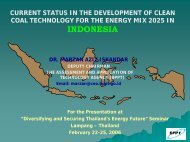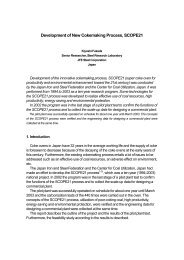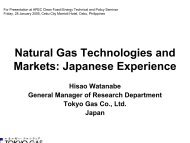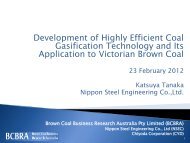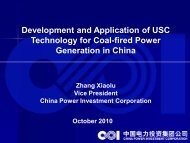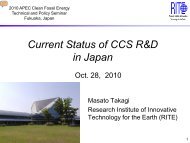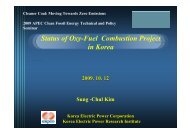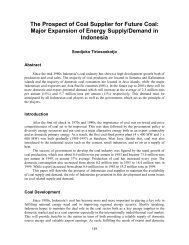Defining CCS Ready: An Approach to An International Definition
Defining CCS Ready: An Approach to An International Definition
Defining CCS Ready: An Approach to An International Definition
- No tags were found...
You also want an ePaper? Increase the reach of your titles
YUMPU automatically turns print PDFs into web optimized ePapers that Google loves.
Appendix B: Technology Design Options for a Capture <strong>Ready</strong> PlantSyngas CleanupOne of the significant areas of potential improvement in IGCC technology is the process ofsyngas cleanup. In order <strong>to</strong> avoid damaging the turbine, particulate materials and othercontaminants must be removed before the syngas produced by the gasifier is injected in<strong>to</strong>the gas turbine.Conventional syngas cleanup is generally accomplished by cooling the syngas <strong>to</strong>temperatures as low as 38ºC or less (the coldest point is usually the syngas desulphurizationusing chemical or physical absorption processes). To humidify syngas before firing andpossibly before shifting, the syngas needs <strong>to</strong> be re-heated. To avoid these temperaturechanges and thus improve electrical efficiency and cost, less complex syngas cleanup systemswith moderately cooled syngas requirements (“warm gas cleanup”) are being developed.Warm gas cleanup processes may use solid sorbents for the removal of chlorides andsulphur at high temperatures of around 480ºC.Warm gas cleanup is projected <strong>to</strong> cost about 25 percent less than cold gas cleanup. Whencapital costs are measured on a $/kW basis, they are further reduced as both the steampower output is increased and auxiliary power requirements are lowered. 148 It should benoted that higher temperature syngas cleanup has been pursued for decades, so far withoutsuccess in terms of complete cleanup systems and actual commercial introduction.Oxygen GenerationAir separation provides high-purity oxygen (around 95%) for the gasifier. Currently, this isachieved by using a cryogenic process in which air is cooled <strong>to</strong> a liquid state and thendistilled. There are, however, new technologies for oxygen generation—as discussed abovein the oxy-fuel combustion sections.Advanced Syngas TurbineTesting shows that hydrogen diluted with nitrogen could be fired in current-vintage F-Classgas turbines. However, achieving significantly higher efficiencies, reduced emissions, andlower costs will require advances in combus<strong>to</strong>r technology, materials, and aerodynamics.R&D strives <strong>to</strong> increase efficiency by 2% <strong>to</strong> 5% compared with the conventional combus<strong>to</strong>rF-frame turbines. 148 Coupling the advanced syngas turbine with a low-cost air separationprocess can further increase efficiency gains and reduce cost.Dry Coal Feed PumpNew coal feed pump technology can lead <strong>to</strong> improvements in gasifier efficiency comparedwith slurry fed gasifiers, as evaporation of the slurry is no longer required. According <strong>to</strong>NETL an efficiency gain of around 1% can be achieved this way.148 U.S. Department of Energy, National Energy Technology Labora<strong>to</strong>ry (U.S. DOE-NETL). (2008c). Current and futureIGCC technologies (DOE/NETL Publication no. 2008/1337).23 February 2010 95



